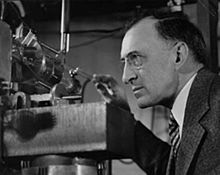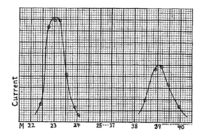| This article needs additional citations for verification. Please help improve this article by adding citations to reliable sources. Unsourced material may be challenged and removed. Find sources: "Arthur Jeffrey Dempster" – news · newspapers · books · scholar · JSTOR (August 2024) (Learn how and when to remove this message) |
| Arthur Jeffrey Dempster | |
|---|---|
 Dempster, c. 1925-30 Dempster, c. 1925-30 | |
| Born | August 14, 1886 Toronto, Ontario, Canada |
| Died | March 11, 1950(1950-03-11) (aged 63) Stuart, Florida, U.S. |
| Nationality | Canadian-American |
| Alma mater | B.S. University of Toronto M.S. University of Toronto Ph.D. University of Chicago |
| Known for | Developed the first modern mass spectrometer, discovered U (used in atomic bombs) |
| Awards | Newcomb Cleveland Prize (1929) |
| Scientific career | |
| Fields | Physics |
| External videos | |
|---|---|
 | |
Arthur Jeffrey Dempster (August 14, 1886 – March 11, 1950) was a Canadian-American physicist best known for his work in mass spectrometry and his discovery in 1935 of the uranium isotope U.
Early life and education

Dempster was born in Toronto, Ontario, Canada. He received his bachelor's and master's degrees at the University of Toronto in 1909 and 1910, respectively. After spending a semester each at Gottingen and Munich, Germany, and two years at the University of Wurzburg under Wilhelm Wien he left at the outset of World War I for the United States; there he completed his Ph.D. in physics, graduating summa cum laude, at the University of Chicago originally begun in Germany under Wien.
Academic career
Dempster joined the physics faculty at the University of Chicago in 1916 and remained there until his death in 1950. He co-developed a double-focusing mass spectrograph in 1936 with the help of the Americans Kenneth T. Bainbridge and J.H.E. Mattauch of Austria. This apparatus allowed the measurement of the mass of atomic nuclei.
During World War II he worked on the secret Manhattan Project to develop the world's first nuclear weapons.
Dempster used a mass spectrometer of his design, in 1935 to find uranium-235, an isotope of uranium which is lighter than uranium-238 and allowed for the production of atomic weaponry, and later energy. The quantity of uranium-235 in naturally occurring uranium is only 0.7%.
Dempster was elected to the American Philosophical Society in 1932 and the United States National Academy of Sciences in 1937.
From 1943 to 1946, Dempster was chief physicist of the University of Chicago's Metallurgical Laboratory or "Met Lab" which integrally related to the Manhattan Project and was founded to study the materials necessary for the manufacture of atomic bombs.
In 1946, he took a position as a division director at the Argonne National Laboratory.
Dempster died on March 11, 1950, in Stuart, Florida, at the age of 63 of a myocardial infarction whilst on vacation.
Research
In 1918, Dempster developed the first modern mass spectrometer, a scientific apparatus allowing physicists to identify compounds by the mass of elements in a sample, and determine the isotopic composition of elements in a sample. Dempster's mass spectrometer was over 100 times more accurate than previous versions, and established the basic theory and design of mass spectrometers that is still used to this day. Dempster's research over his career centered on the mass spectrometer and its applications, leading in 1935 to his discovery of the uranium isotope U. This isotope's ability to cause a rapidly expanding fission nuclear chain reaction allowed the development of the atom bomb and nuclear power. Dempster was also well known as an authority on positive rays.
References
- Allison, Samuel K. (1952). "Arthur Jeffrey Dempster 1886–1950" (PDF). National Academy of Sciences. Retrieved 13 December 2012.
- "APS Member History". search.amphilsoc.org. Retrieved 2023-06-28.
- "Arthur J. Dempster". www.nasonline.org. Retrieved 2023-06-28.
- Dempster, A. J. (April 1918). "A New Method of Positive Ray Analysis". Phys. Rev. 11 (4): 316–325. Bibcode:1918PhRv...11..316D. doi:10.1103/PhysRev.11.316.
- "Today in Science History".
- Armstrong, David; Burke, Monte (December 23, 2002). "85 Innovations 1917-193". Forbes. Archived from the original on December 17, 2002. Retrieved 13 December 2012.
- 1886 births
- 1950 deaths
- People from Old Toronto
- University of Toronto alumni
- University of Chicago alumni
- 20th-century American physicists
- American nuclear physicists
- Canadian physicists
- Canadian nuclear physicists
- Mass spectrometrists
- Manhattan Project people
- Fellows of the American Physical Society
- Members of the United States National Academy of Sciences
- Presidents of the American Physical Society
- Canadian emigrants to the United States
- Members of the American Philosophical Society